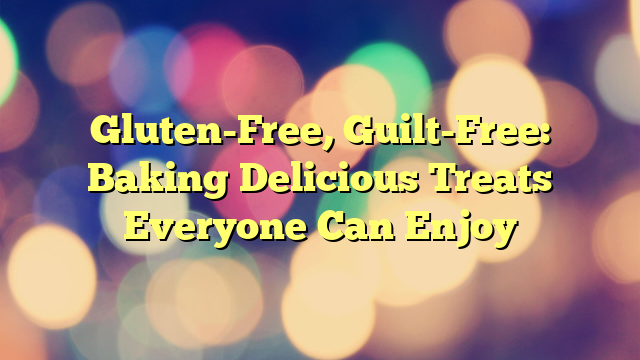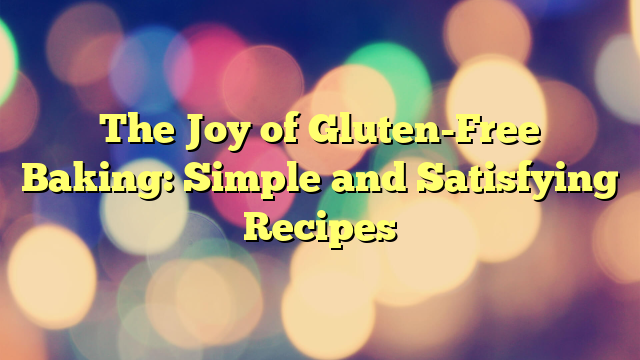Gluten-Free, Guilt-Free: Baking Delicious Treats Everyone Can Enjoy

Gluten-free baking has become increasingly popular as more and more people are adopting gluten-free diets due to health concerns or personal preferences. While it may seem challenging to create delicious treats without traditional wheat flour, there are plenty of options available that not only cater to those with dietary restrictions but also satisfy the taste buds of everyone. In this article, we will explore some tips and recipes to help you bake gluten-free treats that are both guilt-free and delightful.
Understanding Gluten-Free Baking
Before diving into the recipes and techniques for gluten-free baking, it’s essential to understand what makes it different from conventional baking. Gluten is a protein found in wheat, barley, and rye, which gives dough its elastic texture. When baking without gluten, it’s crucial to find alternative ingredients that can mimic this texture and provide the desired structure to the baked goods.
Gluten-free baking requires the use of flours and starches that are free from gluten. These alternative ingredients provide the necessary structure and texture to your baked goods. It’s important to experiment with different combinations of flours and starches to find the perfect blend for each recipe.
Gluten-Free Flours and Starches
One of the first steps in gluten-free baking is finding the right flour and starch combinations to replace wheat flour. There are various options available, each with its unique characteristics. Some popular choices include:
-
Almond Flour: Made from finely ground almonds, almond flour adds a nutty flavor and a moist texture to baked goods. It is an excellent option for cakes, cookies, and muffins. Almond flour is also rich in healthy fats and protein, making it a nutritious choice.
-
Coconut Flour: Made from dried and ground coconut meat, coconut flour is highly absorbent and requires additional moisture in recipes. It lends a subtly sweet taste and a light texture to baked goods. Coconut flour is also high in fiber, which can promote digestive health.
-
Rice Flour: Rice flour is made from ground rice and is available in both white and brown varieties. It provides a neutral flavor and a light texture, making it suitable for a wide range of recipes. Rice flour is also easily digestible and gentle on the stomach.
-
Oat Flour: Oat flour is made by grinding gluten-free oats into a fine powder. It adds a mild nutty flavor and a tender crumb to baked goods. Ensure that your oats are certified gluten-free, as cross-contamination may occur during processing. Oat flour is also a good source of fiber and can help regulate blood sugar levels.
In addition to these flours, using starches like tapioca starch, potato starch, or cornstarch can help improve the texture and rise of gluten-free baked goods. These starches act as binders and provide structure to the final product. Experimenting with different combinations of flours and starches will help you find the perfect blend for each recipe.
Gluten-Free Binders and Leavening Agents
Gluten-free flours lack the natural binding properties of wheat flour, making it necessary to incorporate binders into your recipes. Some common binders include:
-
Xanthan Gum: Xanthan gum is a popular gluten-free binder that helps improve the texture and elasticity of baked goods. It is especially useful in recipes that require structure, such as bread or pizza dough. Xanthan gum is derived from fermented corn sugar and is safe for consumption.
-
Psyllium Husk: Psyllium husk is a natural fiber that acts as a binding agent and adds moisture to gluten-free baked goods. It works well in recipes that call for a chewy texture, such as bread or cookies. Psyllium husk is also known for its potential health benefits, including improved digestion and cholesterol levels.
To achieve the desired rise in gluten-free baking, it’s essential to consider suitable leavening agents. Baking powder, baking soda, yeast, and even eggs can help provide the necessary lift to your treats. These ingredients interact with the other components of the recipe to create a light and fluffy texture.
Tips for Successful Gluten-Free Baking
-
Measure accurately: Since gluten-free flours have different weights and densities compared to wheat flour, it’s crucial to measure your ingredients accurately. Using a kitchen scale is highly recommended for precise measurements. This ensures that the ratios of ingredients are correct and helps maintain consistency in your baked goods.
-
Ensure a balanced moisture level: Gluten-free flours tend to absorb more moisture than their wheat counterparts, often resulting in dry and crumbly baked goods. Adding extra moisture, such as applesauce, yogurt, or even a little extra oil, can help combat this issue. It’s important to find the right balance of moisture to achieve a moist and tender texture.
-
Let the batter rest: Allowing your gluten-free batter or dough to rest for a few minutes before baking helps the flours and starches hydrate properly, resulting in improved taste and texture. This resting period allows the ingredients to fully absorb the moisture and ensures a more even distribution of flavors.
-
Mix thoroughly: Gluten-free flours often require more mixing to develop the desired structure. Beat your batters a bit longer than you would with traditional recipes to ensure proper incorporation of ingredients and a uniform texture. This helps activate the binding properties of the ingredients and creates a cohesive batter or dough.
Gluten-Free Recipes to Delight
Recipe: Gluten-Free Chocolate Chip Cookies
Preparation time: 15 minutes | Baking time: 12-15 minutes | Yield: 24 cookies
Ingredients:
- 1 cup almond flour
- 1/2 cup coconut flour
- 1/2 teaspoon baking soda
- 1/4 teaspoon salt
- 1/2 cup unsalted butter, softened
- 1/2 cup brown sugar
- 1/4 cup granulated sugar
- 1 large egg
- 1 teaspoon vanilla extract
- 1 cup gluten-free chocolate chips
Instructions:
- Preheat the oven to 350°F (175°C) and line a baking sheet with parchment paper.
- In a medium bowl, whisk together the almond flour, coconut flour, baking soda, and salt. Set aside.
- In a large bowl, cream together the softened butter, brown sugar, and granulated sugar until light and fluffy.
- Beat in the egg and vanilla extract until well combined.
- Gradually add the dry ingredients to the wet mixture, mixing until a dough forms.
- Stir in the chocolate chips until evenly distributed throughout the dough.
- Using a cookie scoop or tablespoon, drop rounded portions of dough onto the prepared baking sheet, spacing them about 2 inches apart.
- Bake for 12-15 minutes or until the edges are lightly golden.
- Allow the cookies to cool on the baking sheet for a few minutes before transferring them to a wire rack to cool completely.
Enjoy these delicious gluten-free chocolate chip cookies with a glass of milk or a cup of your favorite hot beverage!
Conclusion
Gluten-free baking doesn’t have to be a daunting task. With the right ingredients, techniques, and recipes, you can create delectable treats that everyone can enjoy, regardless of dietary restrictions. Experimenting with different flours, binders, and leavening agents will help you discover new flavors and textures, opening up a world of possibilities in the realm of gluten-free baking. So go ahead, indulge in guilt-free gluten-free treats that will leave you craving for more!

